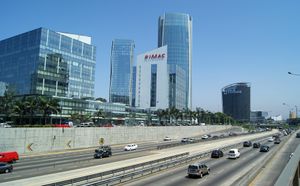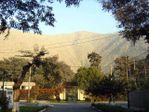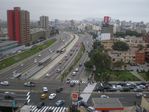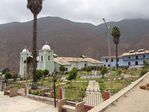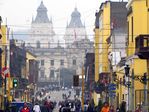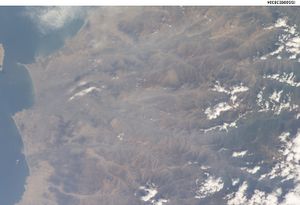منطقة ليما
Lima | |
|---|---|
|
Departamento de Lima | |
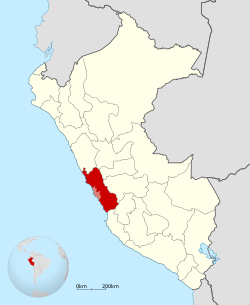 Location of the Lima region in Peru | |
| البلد | |
| الحكومة | |
| • العمدة | نلسون تشوي (2015–2018) |
| المساحة | |
| • الإجمالي | 32٬129٫31 كم² (12٬405٫20 ميل²) |
| التعداد (2011) | |
| • الإجمالي | 800٬588 |
| الموقع الإلكتروني | www.regionlima.gob.pe |
The Department of Lima (النطق الإسپاني: [ˈlima]) is located in the central coast of the country, its regional seat (capital city) is Huacho. Lima Province, which contains the city of Lima, the country's capital, is located west of the Lima Region; this province is autonomous and not under the jurisdiction of the Regional Government.
الجغرافيا
The region is bordered by the Ancash Region on the north, the Huánuco Region, Pasco Region, and Junín Region on the east, the Huancavelica Region on the southeast, the Ica Region on the south, and the Pacific Ocean and the Lima Province on the west.
The region has a coastal and an Andean zone, and has a great diversity of natural regions: the Costa or Chala (0 to 500 meters above sea level) up to the Janka or Cordillera (over 4800 meters). The predominating regions are the Yunga (500 to 2300 meters above sea level) and Quechua (2300 to 3500 meters)
المعالم
Lomas de Lachay
The Lomas de Lachay, a unique mist-fed eco-system of wild plant and animal species, is a natural reserve located in the region.
Lunahuaná
Lunahuaná District of Cañete Province, is located 38 km away from the city of San Vicente de Cañete. The Incahuasi Archeological complex is located there. Lunahuaná has a dry climate and the sun shines during most of the year. Lately, Lunahuaná has become an adventure sports paradise, such as: Canotaje (Whitewater Rafting), Parapente & Ala Delta. Whitewater rafting is possible due to the Cañete River, which has rapids up to level 4. The main settlement in this district is the town of Lunahuaná.
التاريخ
The remains of early Andean inhabitants, hunters and harpoon fishermen from more than 10,000 years ago, are to be found in the Lima region. These remains were found in Chivateros, near the Chillón River, and in various other places. These persons incorporated nets, hooks, farming, ceramics and weaving to their everyday objects. The inhabitants of the coast lived in the lomas and the valleys, where they built temples and dwelling complexes, leading to huge ceremonial centers, such as the Huacoy on the Chillón River; Garagay and La Florida (prehistoric) on the Rímac River, Manchay on the Lurín River; and Chancay, Supe and many other valleys to the north and south. There are finely ornamented temples with figures modeled in clay.
Lithic prehistoric projectile points of Paijan type were found at Ancon (archaeological site) 40 kilometres north-east of Lima in the Chillón River Valley.
The 5,000-year-old ruins known as El Paraíso, Peru are also located in this area. A temple at the site is believed to be about 5,000 years old.
In 2006, a team of archeological researchers led by Robert Benfer announced their findings from a four-year excavation at Buena Vista, Peru in the Chillón River valley a few miles north of present-day Lima. They had discovered a 4200-year-old observatory constructed by an early Andean civilization, a three-dimensional sculpture, unique for the time period in this region, and sophisticated carvings. The observatory is on top of a 33-foot pyramidal mound and has architectural features for sighting the astronomical solstices. The discovery pushes back the time for the development of complex civilization in the area and has altered scholars' understanding of Preceramic period cultures in Peru.[1]
The Lima culture (100 A.D. to 650 A.D.) arose in this area, specially in the central valleys from Chancay to Lurín. It was distinguished by painted adobe buildings.
During this time, the Huari conquest took place, thus giving rise to Huari-style ceramics, together with a local style known as Nievería. As the population grew, their culture changed. With the decline of the Huari, whose most important center was Cajamarquilla, new local cultures arose. The Chancay are the most well known. They developed large urban centers and a considerable textile production, as well as mass-produced ceramics.
At this stage in the mid-fifteenth century, the Incas arrived from their base in the Andes. They conquered and absorbed the regional cultures and occupied important sites such as Pachacamac, turning it into an administrative center.
التقسيمات السياسية
The region is divided into 10 provinces, which are composed of 171 districts.
- Lima (Lima)
- Barranca (Barranca)
- Cajatambo (Cajatambo)
- Cañete (San Vicente de Cañete)
- Canta (Canta)
- Huaral (Huaral)
- Huarochirí (Matucana)
- Huaura (Huacho)
- Oyón (Oyón)
- Yauyos (Yauyos)
معالم
الهامش
- ^ Richard Lovett, "Oldest Observatory in Americas Discovered in Peru", National Geographic, May 2006, accessed 2 Nov 2010
وصلات خارجية
- Lima Region Information Hub – Lima Region Information Hub official website
- Lima Region Tourism Board – Lima Region Tourism Board (CEPTUR) official website
- North Lima Region – Lima Region: Social, Cultural and Tourist Information
- Lima Travel Guide – General facts and travel information about Lima
- Gobierno Regional Lima – Lima Regional Government official website
